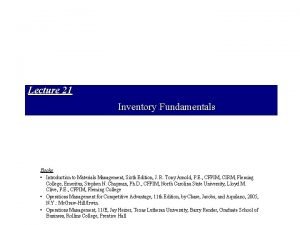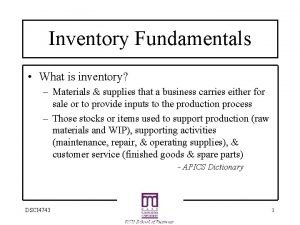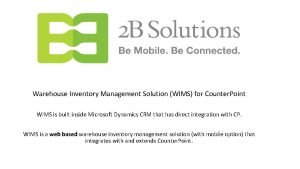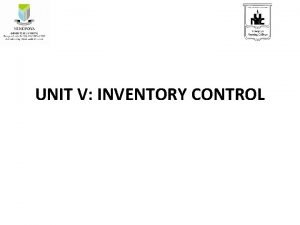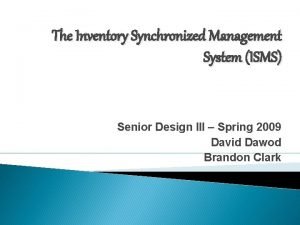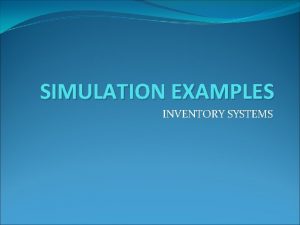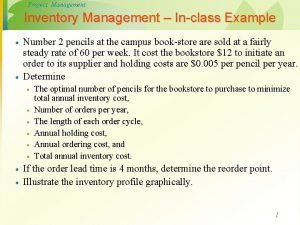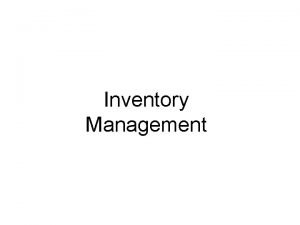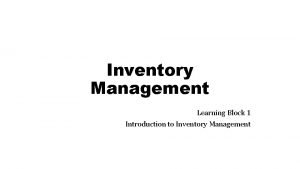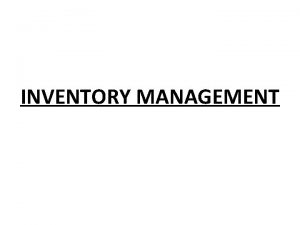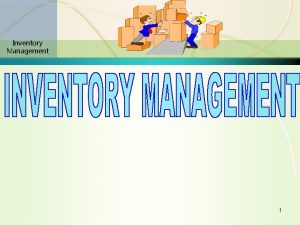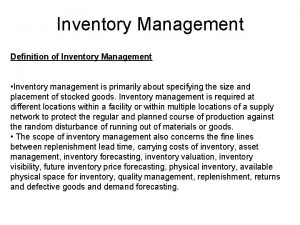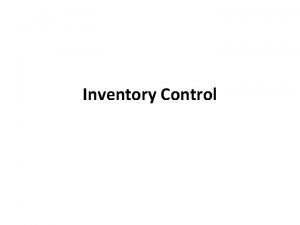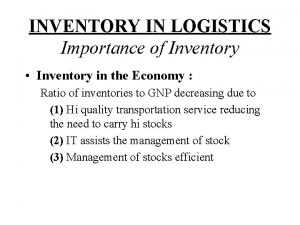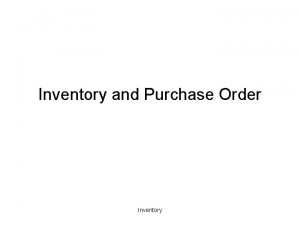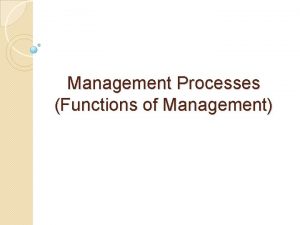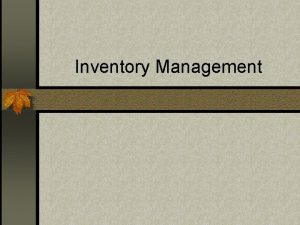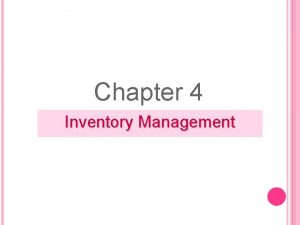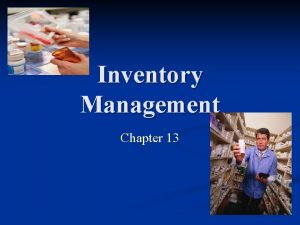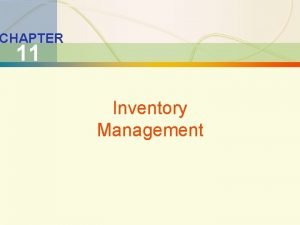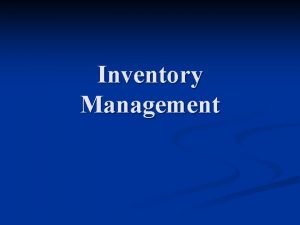Inventory Management 1 Inventory Management FUNCTIONS OF INVENTORY






















- Slides: 22

Inventory Management 1

Inventory Management FUNCTIONS OF INVENTORY 2

Inventory Management FUNCTIONS OF INVENTORY • To meet anticipated demand. • To smoothen production requirements. • To decouple operations. INVENTORY SUPPLY PROCESS PRODUCTS DEMAND PROCESS DEMAND 3

Inventory Management Functions Of Inventory (Cont’d) • To protect against stock-outs. • To take advantage of order cycles. • To help hedge against price increases. • To permit operations. • To take advantage of quantity discounts. 4

Inventory Management SELECTIVE INVENTORY CONTROL 5

Inventory Management SELECTIVE INVENTORY CONTROL • Selective Inventory Control is defined as a process of classifying items into different categories, thereby directing appropriate attention to the materials in the context of company’s viability. 6

Classification of Materials for Inventory Control Classification Criteria A-B-C Annual value of consumption of the items V-E-D Critical nature of the components with respect to products. H-M-L Unit price of material F-S-N Issue from stores S-D-E Purchasing problems in regard to availability S-O-S Seasonality G-O-L-F X-Y-Z Channel for procuring the material Inventory value of items stored 7

ABC Classification System Inventory Management Classifying inventory according to annual value of consumption of the items. A - very important B - mod. important C - least important High Annual $ value of items A B C Low Few Many Number of Items 8

Inventory Management ABC Classification System (Cont’d) • When a large number of items are involved, relatively few items account for a major part of activity, based on annual value of consumption of items. • It is based on the principles of ‘vital few and trivial many’. 9

Inventory Management ABC Classification System (Cont’d) • A-items : 15% of the items are of the highest value and their inventory accounts for 70% of the total. • B-items : 20% of the items are of the intermediate value and their inventory accounts for 20% of the total. • C-items : 65%(remaining) of the items are lowest value and their inventory accounts for the relatively small balance, i. e. , 10%. 10

Procedure for classification Inventory Management • All items used in an industry are identified. • All items are listed as per their value. • The number of items are counted and categorized as high-, medium- and lowvalue. • The percentage of high-, medium- and low - valued items are determined. 11

Inventory Counting Systems Inventory Management • Periodic System Physical count of items made at periodic intervals. • Perpetual Inventory System that keeps track of removals from inventory continuously, thus monitoring current levels of each item. 12

Inventory Counting Systems Inventory Management (Cont’d) • Two-Bin System - Two containers of inventory; reorder when the first is empty. • Universal Bar Code - Bar code printed on a label that has information about the item to which it is attached. 214800 232087768 13

Inventory Management Pareto curve 14

Inventory Management V-E-D Classification • Based on the critical nature of items. • Applicable to spare parts of equipment, as they do not follow a predictable demand pattern. • Very important in hospital pharmacy. 15

V-E-D Classification (Cont’d) Inventory Management • V-Vital : Items without which the activities will come to a halt. • E-Essential : Items which are likely to cause disruption of the normal activity. • D-Desirable the which absence of the : In hospital work does not get hampered. 16

H-M-L Classification Inventory Management • Based on the unit value (in rupees) of items. • Similar to A-B-C analysis H-High M-Medium L -Low 17

F-S-N Classification Inventory Management • Takes into account the distribution and handling patterns of items from stores. • Important when obsolescence is to be controlled. F – Fast moving S – Slow moving N – Non moving 18

S-D-E Classification Inventory Management • Based on the lead-time analysis and availability. S – Scarce : longer lead time D – Difficult : long lead time E – Easy : reasonable lead time 19

S-O-S Classification Inventory Management • S-O-S : Seasonal- Off- Seasonal • Some items are seasonal in nature and hence require special purchasing and stocking strategies. • EOQ formula cannot be applied in these cases. • Inventories at the time of procurement will be extremely high. 20

G-O-L-F Classification Inventory Management • G-O-L-F stands for: G – Government O – Ordinary L – Local F – Foreign 21

X-Y-Z Classification Inventory Management • Based on the value of inventory stored. • If the values are high, special efforts should be made to reduce them. • This exercise can be done once a year. 22
 Inventory management functions
Inventory management functions Functions of inventory
Functions of inventory Functions of inventory
Functions of inventory Operations management chapter 12 inventory management
Operations management chapter 12 inventory management Absolute value of x as a piecewise function
Absolute value of x as a piecewise function Evaluating functions
Evaluating functions Evaluating functions and operations on functions
Evaluating functions and operations on functions Warehouse inventory management solution (wims)
Warehouse inventory management solution (wims) Fsn meaning in inventory management
Fsn meaning in inventory management Greenhouse inventory software
Greenhouse inventory software Conclusion of inventory management
Conclusion of inventory management Textbook inventory management system
Textbook inventory management system Simulation of inventory system
Simulation of inventory system Inventory system project proposal
Inventory system project proposal Inventory management diagram
Inventory management diagram Production planning and inventory control
Production planning and inventory control Mapics inventory management
Mapics inventory management Inventory management objective
Inventory management objective Introduction to inventory planning
Introduction to inventory planning Fsn meaning in inventory management
Fsn meaning in inventory management Independent and dependent demand
Independent and dependent demand Difference between dependent and independent demand
Difference between dependent and independent demand Factors affecting inventory management
Factors affecting inventory management

